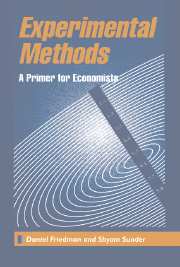Book contents
- Frontmatter
- Contents
- List of figures and tables
- Preface
- Acknowledgments
- EXPERIMENTAL METHODS
- 1 Introduction
- 2 Principles of economics experiments
- 3 Experimental design
- 4 Human Subjects
- 5 Laboratory facilities
- 6 Conducting an experiment
- 7 Data analysis
- 8 Reporting your results
- 9 The emergence of experimental economics
- Appendixes: Supplemental materials
- Glossary
- References
- Index
5 - Laboratory facilities
Published online by Cambridge University Press: 05 June 2012
- Frontmatter
- Contents
- List of figures and tables
- Preface
- Acknowledgments
- EXPERIMENTAL METHODS
- 1 Introduction
- 2 Principles of economics experiments
- 3 Experimental design
- 4 Human Subjects
- 5 Laboratory facilities
- 6 Conducting an experiment
- 7 Data analysis
- 8 Reporting your results
- 9 The emergence of experimental economics
- Appendixes: Supplemental materials
- Glossary
- References
- Index
Summary
Until the mid-1970s virtually all economics experiments were conducted using little more than paper, pencil, chalkboard, and a watch in standard classrooms or meeting rooms. Since the early 1980s, more and more experiments rely on computers for data entry, communication, and recordkeeping. Computers bring both advantages and disadvantages. While a few experiments absolutely require a computer (and a few preclude their use), in most cases it is up to you to decide whether to conduct your experiment manually or on a computer. We discuss this issue before describing the facilities you will need for conducting experiments in each mode.
Choosing between manual and computer modes
Manual and computer markets are as different, and as similar, as driving and flying. The choice of transportation is hardly arbitrary; different destinations and objectives of travel call for different choices. Likewise in choosing your experimental mode, you must be clear about the purpose of your experiments.
Paper-and-pencil experiments allow you a great deal of freedom in changing your design, treatments, parameters, and procedures with little effort and delay. In contrast, computer experiments often require the software to be rewritten (and inevitably debugged once again). Unless you are lucky enough to be working with an experimental economics software that already incorporates the variation you wish to make, changing the software can be time consuming. If the software is borrowed, you may not have the source code to make the changes; even if the source code is available, deciphering programs written by others is difficult at best.
- Type
- Chapter
- Information
- Experimental MethodsA Primer for Economists, pp. 61 - 73Publisher: Cambridge University PressPrint publication year: 1994



